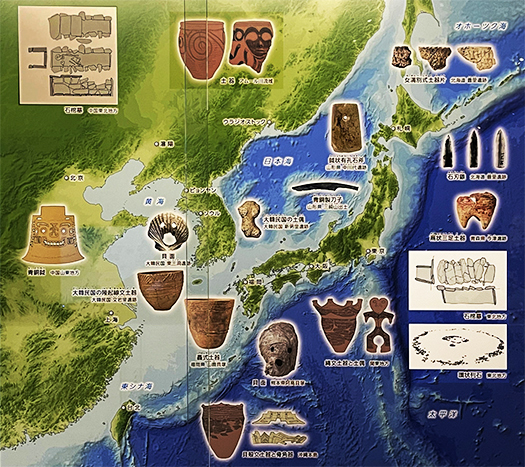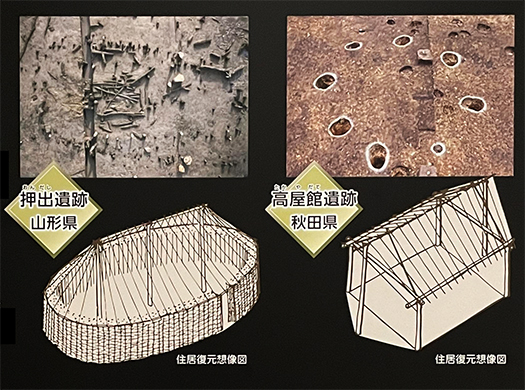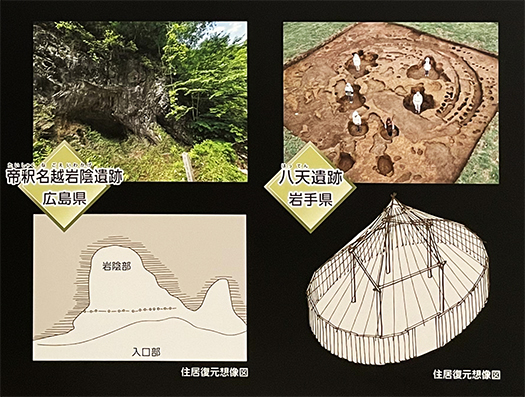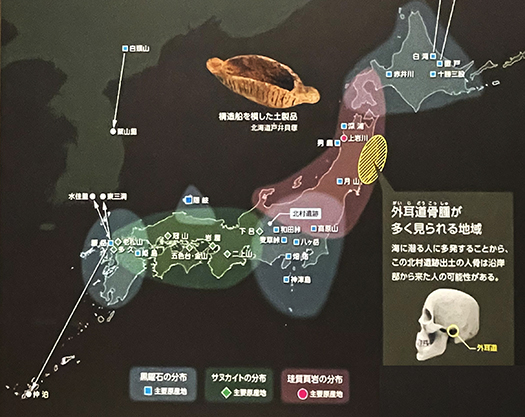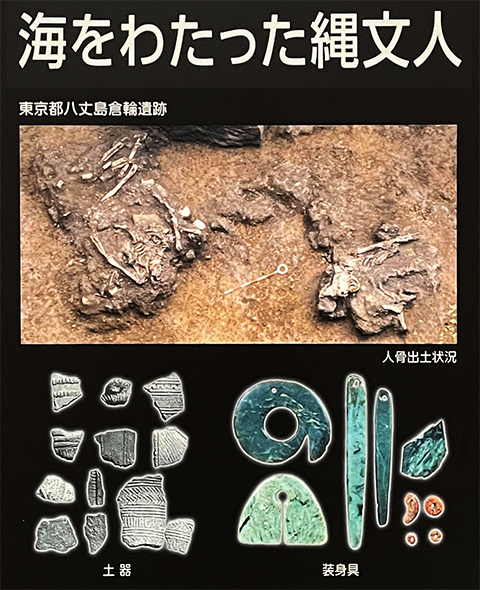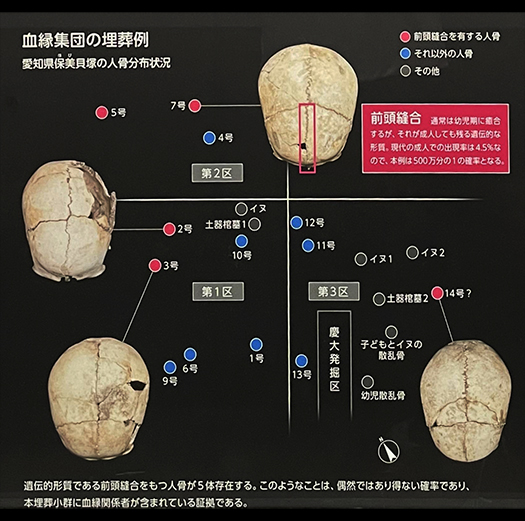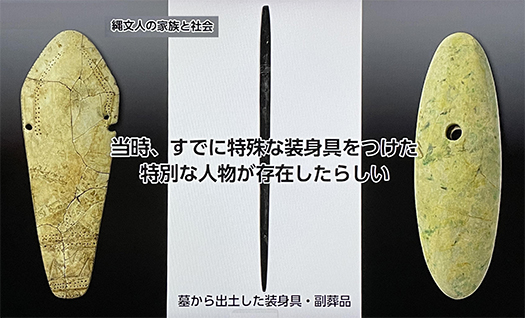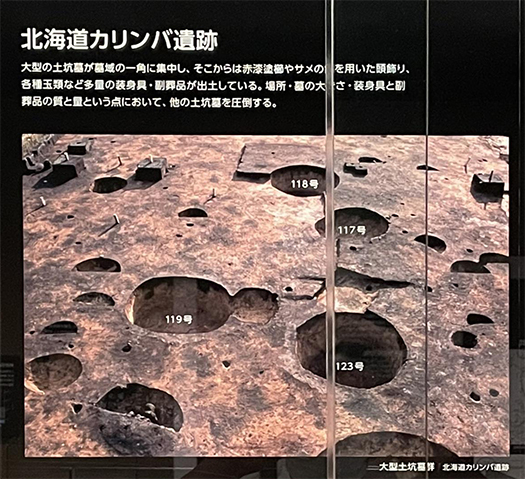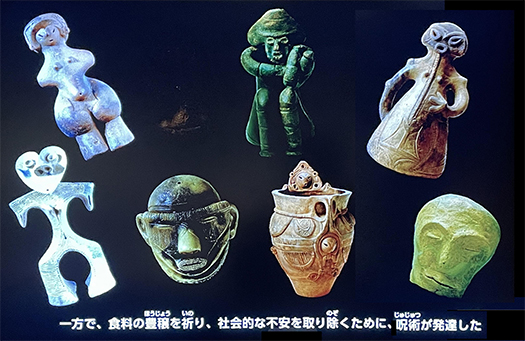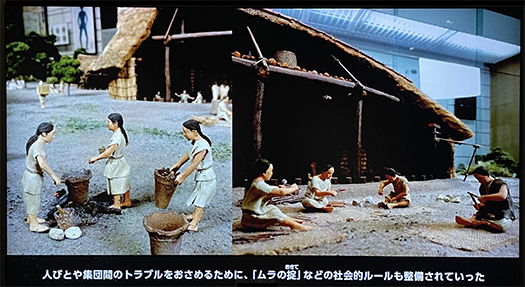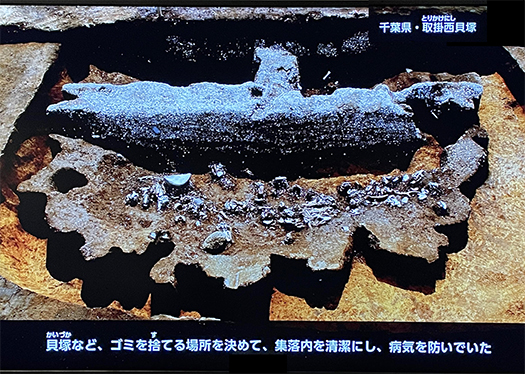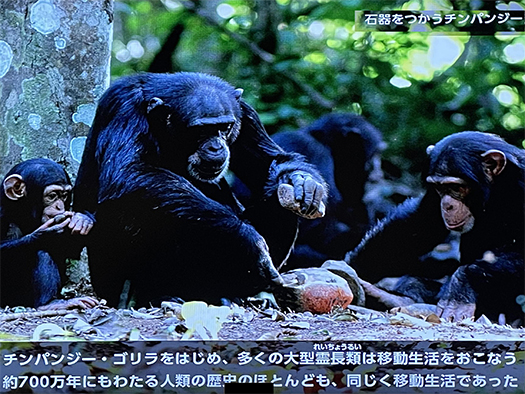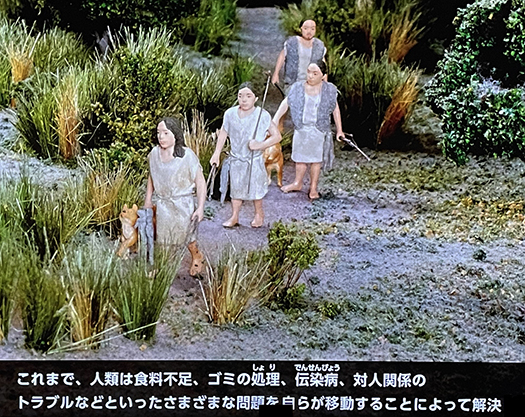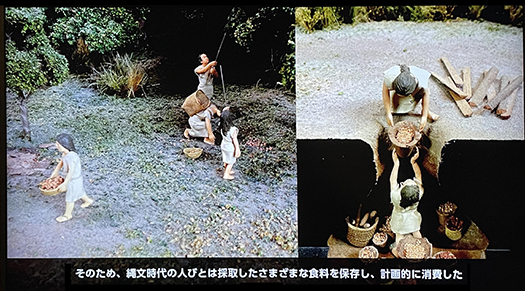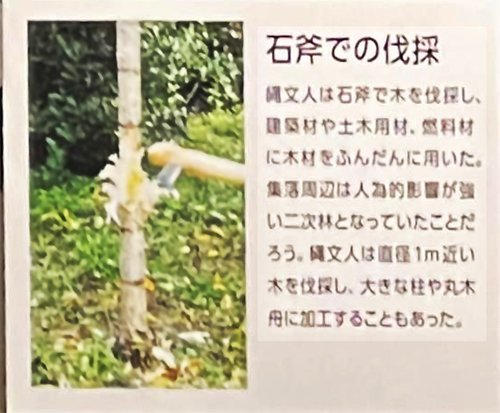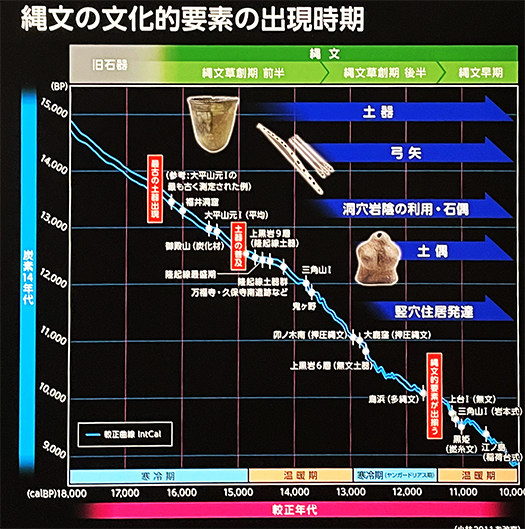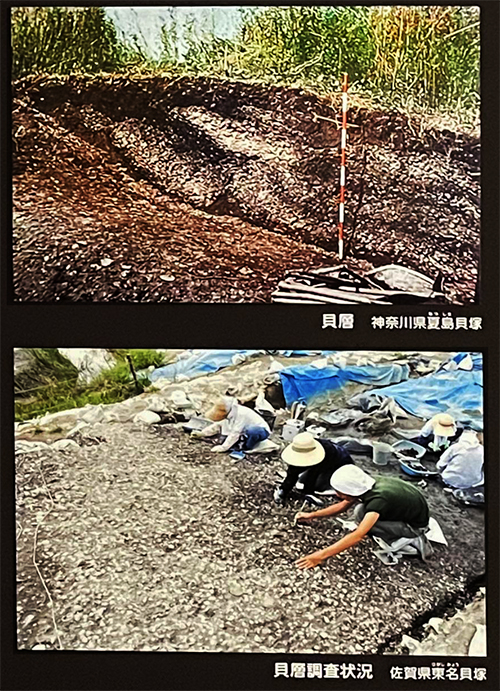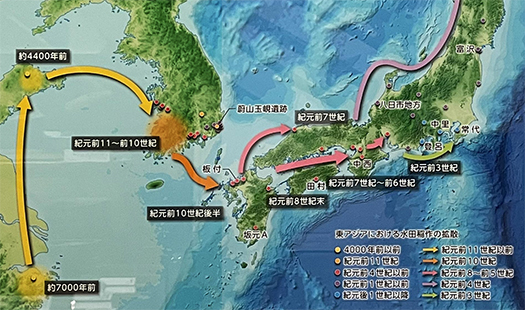
日本列島での人類史のなかで水田農耕は決定的な社会形成要因。
縄文段階では最大でも約20万人程度の人口規模だったと推定されるものが、
大量の食糧を生産し大きな人口を維持できることは革命的だっただろう。
紀元前10世紀、いまから3,000年前頃に北九州地域にやってきて以降、
一粒万倍の事跡は現実に日本列島での発展史で証明されている。
人口規模ではこの3000年間におよそ20万人が1億2,000万人になったのだから
実に600倍の人口を養うほどの主食の位置を占めてきたことになる。
この列島でその後起こった「歴史」とはコメが背景だったといえる。
それほどに決定的な出来事であったに違いない。
あまりにも巨大な出来事なのでいまは想像力も湧き上がりにくいけれど
初源に於いてはまさに巨大な革命力を持ったことだっただろう。
最新研究では稲作起源は中国の長江流域とされ長江下流の河姆渡遺跡から、
約7,000年前の炭化米や稲作に使われたと思われる道具が出土している。
そこからアジア世界全域に広がっていったとされるけれど
気候条件的に日本列島の高温多湿気候は最適だったのか、
コメの無限発展地域として列島社会は旺盛に開発されていった。
さながらコメ革命が日本列島を覆いつくしていった。
縄文の世で泰平の夢に生きてきた人びとにとって
この大変革がどのように受容されていったのか、
たぶん明治の開国インパクトとも比較不能なほどの根源的な革命だと思う。
また逆に、日本という社会はそういう変動に対して従順で
受容することについては非常に柔軟な民族性を持っているのだと思う。
さらに言えば、その変化を「変える」ことも非常にヘタな国民性なのかも。

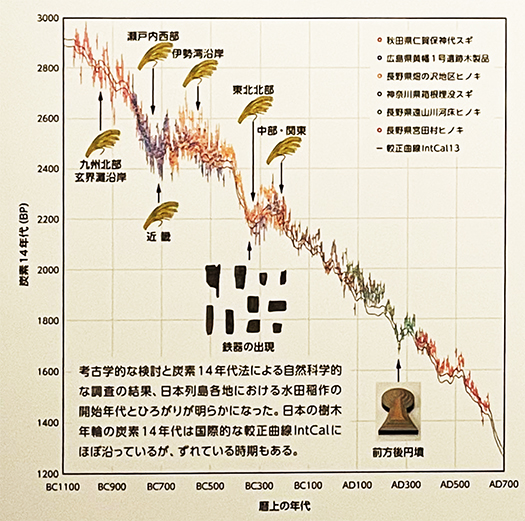
福岡県・板付遺跡での絵図では、3000年前ころの「水利」の様子。
このような水田整地土木を行い、そこに水を引く灌漑土木。
揚子江河口地域での水稲栽培開始からの知恵と工夫が
この列島に導入された段階ではすでに4,000年程度の知見蓄積があって
それに即した先端的技術によって導入されたと思われる。
このとき縄文の世の人びととの社会関係がどうであったか。
たぶん低湿地のような「葦原の中」のような土地に着目して
水田を開拓する様子を見ていて、縄文伝統の暮らしを営んでいた人びとは
どのようにこうした事態を認識していたのか、興味深い。
縄文期では活発な地域間交流が船を利用して行われていたので
そういう交流で朝鮮半島地域から情報と技術が導入されたのは自然な理解。
さまざまな交流形態のひとつとして半島・大陸からの集団移住もあった可能性。
3番目の図は炭素14年代法によるイネの列島地域波及のグラフ。
九州北部から瀬戸内地域、近畿、伊勢湾地域、東北北部、中部関東と
その列島地域への漸進ぶりがきれいに表現されている。
English version⬇
Paddy Field Farming / East Asian World Interaction: 37,000 Years of Japanese Archipelago History-25
Traces of advanced agricultural engineering can be seen in the northern part of Kyushu in the early period. Was the entire advanced rice production technology system introduced to the archipelago? The history of agriculture in Japan and the East Asia
Paddy field agriculture has been a decisive factor in the social formation of the Japanese archipelago throughout human history.
The Jomon period is estimated to have had a population of about 200,000 people.
The ability to produce large amounts of food and sustain a large population would have been revolutionary.
Since its arrival in the Kitakyushu region in the 10th century B.C., around 3,000 years ago, the Japanese people have been able to produce and sustain a large population.
The history of the development of the Japanese archipelago has proven that the “one grain, ten thousand times as large” concept is in fact a reality.
In terms of population, the number of people has increased from 200,000 to 120 million over the past 3,000 years.
This means that the staple food has occupied a position that can feed a population 600 times larger than before.
The “history” that followed in this archipelago can be said to have had rice as its backdrop.
It must have been such a decisive event.
It was so huge that it is hard to imagine now.
But at its origin, it must have had a revolutionary power.
According to the latest research, rice cultivation originated in China’s Yangtze River basin, and the remains of the Samudu site on the lower reaches of the Yangtze River have yielded evidence of charcoal production dating back approximately 7,000 years.
Carbonized rice and tools believed to have been used for rice cultivation have been excavated from the ruins at the Kawamudu site on the lower reaches of the Yangtze River, which date back approximately 7,000 years.
From there, it is believed to have spread throughout the Asian world.
The hot and humid climate of the Japanese archipelago may have been optimal for rice cultivation, but it is also believed to have spread throughout Asia and the rest of the world.
The Japanese archipelago society was vigorously developed as a region of unlimited rice development.
A rice revolution swept over the Japanese archipelago.
For those who had lived the dream of peace in the Jomon era
How was this revolution received by the people who had lived the dream of peace in the Jomon period?
I think it was a revolution so fundamental that it probably cannot be compared to the impact of the opening of Japan to the outside world in the Meiji era.
On the other hand, Japanese society has been very flexible in accepting such changes.
I think, on the other hand, Japanese society has a very flexible ethnicity in terms of accepting such changes.
Furthermore, Japan may not be very good at “changing” such changes.
A drawing at the Itazuke site, Fukuoka Prefecture, shows “water use” around 3,000 years ago.
Irrigation civil engineering to draw water to such paddy field preparation civil engineering.
The wisdom and ingenuity from the start of paddy rice cultivation in the Yangtze River estuary area
The knowledge accumulated over 4,000 years has already been accumulated at the stage when it was introduced to this archipelago.
It is thought that the technology was introduced in line with this knowledge.
What was the social relationship with the Jomon people at this time?
Perhaps they focused on the land “in the reed field” like low marshland
How did the people of the Jomon tradition of living perceive this situation?
It is interesting to see how they perceived these situations.
During the Jomon period, active inter-regional exchanges took place by ship, so it is interesting to see how people who lived a traditional Jomon lifestyle would have perceived this situation.
It is natural that information and technology were introduced from the Korean peninsula through such exchanges.
It is possible that migration from the peninsula and continent was one of the various forms of exchange.
The third figure is a graph of rice spreading across the archipelago based on carbon-14 dating.
The chart shows the gradual spread of rice from northern Kyushu to the Setouchi area, Kinki area, Ise Bay area, northern Tohoku area, central Kanto area, and so on.
The gradual progression of rice to the archipelagic regions is beautifully expressed in this graph.
Posted on 11月 25th, 2022 by 三木 奎吾
Filed under: 日本社会・文化研究, 歴史探訪 | No Comments »



